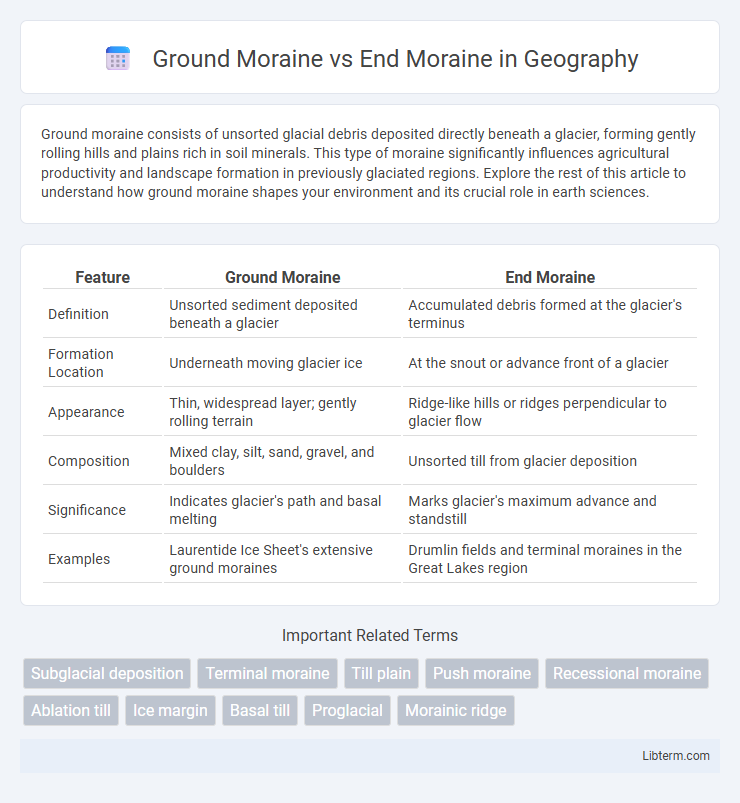Ground moraine consists of unsorted glacial debris deposited directly beneath a glacier, forming gently rolling hills and plains rich in soil minerals. This type of moraine significantly influences agricultural productivity and landscape formation in previously glaciated regions. Explore the rest of this article to understand how ground moraine shapes your environment and its crucial role in earth sciences.
Table of Comparison
| Feature | Ground Moraine | End Moraine |
|---|---|---|
| Definition | Unsorted sediment deposited beneath a glacier | Accumulated debris formed at the glacier's terminus |
| Formation Location | Underneath moving glacier ice | At the snout or advance front of a glacier |
| Appearance | Thin, widespread layer; gently rolling terrain | Ridge-like hills or ridges perpendicular to glacier flow |
| Composition | Mixed clay, silt, sand, gravel, and boulders | Unsorted till from glacier deposition |
| Significance | Indicates glacier's path and basal melting | Marks glacier's maximum advance and standstill |
| Examples | Laurentide Ice Sheet's extensive ground moraines | Drumlin fields and terminal moraines in the Great Lakes region |
Introduction to Moraines
Ground moraines are extensive, gently rolling deposits of till left behind by retreating glaciers, forming a foundation layer of unsorted sediment. End moraines appear as ridges composed of accumulated glacial debris marking the furthest advance of a glacier, indicating its terminal position. Both types of moraines serve as key indicators of past glacial movement and landscape shaping in glaciology.
What is a Ground Moraine?
A ground moraine is a continuous layer of unsorted glacial till deposited beneath a glacier as it advances or retreats, creating gently rolling or flat terrain. It primarily consists of a mixture of clay, sand, gravel, and boulders, reflecting the heterogeneous material transported by the glacier. Unlike an end moraine, which forms a distinct ridge at the glacier's terminus, ground moraines blanket large areas and represent the glacier's basal debris.
What is an End Moraine?
An end moraine is a ridge-like accumulation of glacial debris deposited at the terminus of a glacier, marking its furthest advance. It consists of unsorted soil, rocks, and sediment pushed forward by the glacier's movement. Unlike ground moraine, which forms a blanket of till beneath a glacier, end moraine indicates the glacier's paused or retreating position during its melting phase.
Formation Processes of Ground Moraine
Ground moraine forms through the gradual deposition of unsorted glacial till beneath a melting glacier, resulting in a gently rolling landscape composed of clay, sand, gravel, and boulders. The debris is transported by basal ice and released as the glacier retreats, creating a widespread layer rather than distinct ridges. In contrast, end moraines develop as prominent ridges at glacier termini where accumulated sediments mark the glacier's maximum advance and stagnation periods.
Formation Processes of End Moraine
End moraines form at the terminus of a glacier where debris accumulates from the ice's forward movement and melting, creating ridges of unsorted sediment. This process involves the glacier pushing and depositing till as it advances or remains stationary, marking its maximum extent. In contrast, ground moraines are formed by the widespread deposition of till beneath a glacier, resulting in a more even, gently rolling landscape without distinct ridges.
Key Differences Between Ground and End Moraines
Ground moraines consist of unsorted, widespread till deposits formed beneath glaciers as they retreat, creating gently rolling landscapes. End moraines are ridges of debris accumulated at the glacier's terminus, marking the furthest advance and indicating glacier stability during stagnation. The key differences lie in their formation processes, morphology, and spatial distribution--ground moraines are broad and subtle, while end moraines are prominent, linear, and signify glacier margins.
Physical Characteristics and Appearance
Ground moraines are extensive, gently undulating deposits of unsorted till that form a blanket over the landscape, characterized by a relatively flat or slightly rolling topography. End moraines consist of ridges or mounds of glacial debris piled at the terminus of a glacier, displaying a more pronounced, elevated, and often arcuate shape. The physical difference lies in ground moraines being widespread and low-relief, while end moraines are linear and conspicuous features marking glacier pauses.
Geographic Distribution and Examples
Ground moraines are widespread landforms found beneath glacier ice sheets across North America and Northern Europe, characterized by gently rolling topography formed by unsorted glacial till. End moraines occur at the terminal edge of glaciers, marking the furthest advance of ice sheets, with notable examples including the Long Island moraines in New York and the Foothills of the Rocky Mountains in Alberta. Their distinct geographic distribution highlights ground moraines as extensive subsurface deposits, while end moraines define glacial margins and past ice front positions.
Environmental and Geological Significance
Ground moraines consist of an uneven layer of glacial till deposited directly by melting glaciers, playing a crucial role in soil formation and nutrient distribution that supports diverse ecosystems. End moraines form at the glacier's terminus, marking the furthest advance of ice sheets and serving as important indicators for studying past climate changes and glacial dynamics. Both moraine types influence local hydrology by shaping drainage patterns and groundwater flow, impacting environmental stability and landscape evolution.
Summary: Choosing Ground or End Moraine for Study
Ground moraines are formed from till deposited directly beneath a glacier, offering valuable insights into glacier movement and subglacial processes. End moraines, created at the glacier's terminus from accumulated debris, provide important information on glacier advance and retreat patterns. Selecting between ground moraine and end moraine for study depends on whether the focus is on understanding glacial dynamics beneath the ice or reconstructing past glacier extent and climatic conditions.
Ground Moraine Infographic

 libterm.com
libterm.com